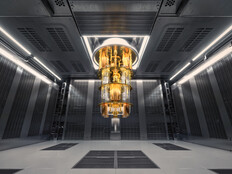In a Flash

Conventional hard-drive cache is created from volatile memory erased when a drive powers down. A new prototype hybrid hard drive adds another layer of cache
consisting of nonvolatile Flash memory that’s accessed when the drive powers up. Samsung is behind these new HHDs, which should be available in mobile computers shortly.
How It Works
Samsung’s prototype HHDs have 128- or 256-megabyte buffers — compared to the 8- to 16-MB cache of current hard drives. The more expansive buffer differs from the typical cache buffer not only in size but also in structure, composition and other qualities. Adding a large buffer to a hard drive also reduces a system’s power consumption, thereby increasing battery life by reducing the time required for the system to resume operation following suspension. Indeed, boot or resume time should occur about twice as fast compared with conventional hard drives, saving eight to 25 seconds. The end result: Notebook system batteries should provide 20 to 30 more minutes of power.
Samsung and other manufacturers are pursuing solid state drive (SSD) technology, based entirely on Flash. Currently, Flash prices are too high to allow SSDs to replace standard hard drives of any reasonable size. Although Flash prices continue to fall, it will be several years until such a drive will become affordable to most users. Enter HHD, a near-term solution for enjoying improved performance at a reasonable price by combining low cost and the large storage capacity of conventional hard-drive technology with quick and low-power Flash memory. Samsung expects the HHD to compete price-wise with conventional hard drives.
But will information technology organizations embrace HHDs? Only if the price truly is right, says Waihong Wong, network engineer with the 500-employee New York law firm McKee Nelson.
Most McKee Nelson lawyers use notebook computers as their main platform, so battery life, energy consumption and quick boots are all key considerations, Wong says. Even so, total cost tops these other concerns.
“If it’s much more expensive than conventional drives, we won’t consider it,” he says. “We would need to test the new HHD and see how fast it is.”
The Vista Connection
Apart from the reduction in Flash memory prices, hard-drive manufacturers such as Samsung believe that the IT industry is on the brink of a client-system storage revolution driven by the release of Microsoft Windows Vista.
The retooled Windows operating system introduces three new performance-enhancing technologies:
• SuperFetch learns over time which applications a user taps into most frequently and preloads the apps into memory to improve system responsiveness.
• ReadyBoost supports use of removable Flash memory devices, such as USB thumb drives. ReadyBoost retrieves data stored on the Flash memory more quickly than data stored on the hard drive and speeds PC response times.
• ReadyDrive lets a PC running the Vista OS and equipped with an HHD boot faster and resume from hibernate in less time than the typical drive, which preserves battery power and improves hard-drive reliability.
Speed Source
On a conventional hard drive, the hard-disk platters of circular rigid disks that store magnetic data rotate most of the time, consuming a lot of power. But HHD platters usually remain at rest, as if they were off.
On an HHD, incoming data is generally written to the Flash buffer, and documents are saved to the buffer, instead of to the hard drive. Only once the Flash buffer is almost full or a user accesses a new file not stored on the buffer will the HHD platter rotate.
Any new technology comes with pros and cons, and HHD is no different:
Pros:
- Faster read time: In some cases, twice or more than that of the fastest hard drive.
- Faster nonsequential write time: HHD Flash memory is ideally suited to store small and frequently used files. Although some rotating hard drives have good sequential write performance, they are still significantly slower for small random writes.
- Faster boot time: Samsung claims boot and resume time will drop by half compared to conventional hard drives, saving anywhere from eight to 25 seconds.
- Lower power consumption: On portable machines, batteries will provide about 20 to 30 minutes more power from reduced spinning of the platter.
- Quieter: Reduced spinning of the platter also significantly decreases the noise level of the hard drive.
- More reliable: The reduced use of the mechanical parts decreases the chance of a head crash and less overall wear and tear. Historically, SSDs had limited read/write cycles. According to Samsung, with modern Flash technology and error correction, the reliability of Flash on a PC can exceed 10 years.
Cons:
- Microsoft compatibility: HHDs currently work only with Windows Vista because they require ReadyDrive, solely a Vista feature.
- Increased cost: Adding Flash to hard drives will increase their cost, although at current prices that amounts to a fairly slight premium, depending on the size of the Flash used.
- Slower sequential write time: The OneNAND Flash technology on Samsung HHDs is capable of 18-megabyte-per-second write speeds compared to three times that for high-end conventional drives. According to Samsung, sequential write performance should not be a significant issue with hybrid hard drives. The HHD controller should be able to write large files directly to rotating media as the data does not need to pass through Flash.
- Harder to wipe: Studies have shown that Flash memory retains information even after many rewrite sequences. This might pose a security concern for companies trying to erase sensitive material using
conventional methods for erasing magnetic media that seem less effective on Flash.
Windows Vista operating system.
Additional reporting by Lee Copeland.







